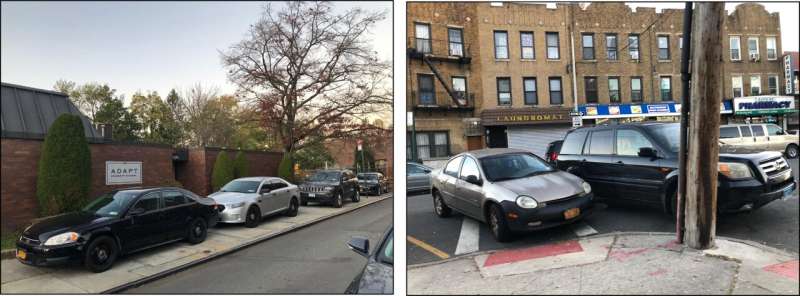April 11, 2023 report
This article has been reviewed according to Science X's editorial process and policies. Editors have highlighted the following attributes while ensuring the content's credibility:
fact-checked
trusted source
proofread
Researcher reveals a double standard for officers who issue parking tickets

"THEY park on the sidewalks and hide fire hydrants with their cars. They angle where they should parallel and turn normal streets into obstacle paths. They never seem to feed their parking meters, they rarely get tickets and they run red lights."
That was the lead paragraph of a New York Times story nearly 30 years ago. Who were these scofflaws? Members of the New York Police Department.
New York City residents know their police force, despite a number of highly publicized cases of corruption and misconduct, generally live up to their adopted slogan "New York's Finest." In a city with 342 robberies and burglaries, 517 arrests and approximately one homicide each day, New York City cops confront one of the most challenging environments in the country. For the most part, they do their jobs commendably.
But in one area—their transportation habits—they received a failing grade back in 1995. In 2023, they are still failing.
Marcel Moran, a University of California Ph.D. student, heard of the problems New Yorkers for years have been complaining about: police department personnel parking their cars by fire hydrants, on sidewalks, on crosswalks. Civilians committing these traffic violations face $115 fines. But under longstanding "code of blue" practices, in which officers extend courtesies to fellow officers, they are rarely if ever ticketed.
Moran set out to document the problem. He utilized archives containing Google Street View maps to track locations throughout the city's five boroughs. In addition, he visited each of the city's 77 police precincts to observe the offending vehicles firsthand.
His research, published in Transportation Research Interdisciplinary Perspectives, confirmed the depth of the problem. He reported "widespread and longstanding parking on sidewalks, and to a lesser extent, in crosswalks… render[ing] many sidewalks impassable—forcing pedestrians into traffic—and in many cases directly abut[ting] residences and businesses, curtailing access to such destinations."
Other violations included double parking, blockage of bicycle and bus lanes and obstructing access to fire hydrants, a particularly vexing offense in the population- and traffic-dense boroughs.
He said 91 percent of precincts exhibited one or more types of parking violations. He also confirmed such obstructions have been going on for years. Based on 12 years' worth of 703 Google Map View photos, he found long-term obstructions at 82 percent of the precincts.
City motorists are understandably resentful. Manhattan absorbs the bulk of a million motorists commuting to work each day. With greatly limited street parking and fewer than 175,000 parking spaces available, finding a spot is frustrating, time-consuming and costly. Some 32,789 parking tickets were issued for sidewalk parking so far this year.
Efforts to curb abuse have generally failed. Mayor Bill de Blasio disbanded a police unit he had earlier created to crack down on parking placard abuse. His successor, former policeman Eric Adams, himself was photographed abusing parking privileges and defended it by saying other officials were doing the same thing.
Writing on the issue in Slate magazine, author Rob Gunther said, "The idea that police officers operate under a different set of rules erodes their ability to serve their communities. Every time a police officer parks on the sidewalk, it's a visible reminder that the laws that regulate the rest of us don't apply to members of law enforcement."
Moran reached out to city officials to discuss how to rein in the abuse. He received no response.
More information: Marcel E. Moran, Authorized Vehicles Only: Police, parking, and pedestrian access in New York City, Transportation Research Interdisciplinary Perspectives (2023). DOI: 10.1016/j.trip.2023.100816
© 2023 Science X Network



















